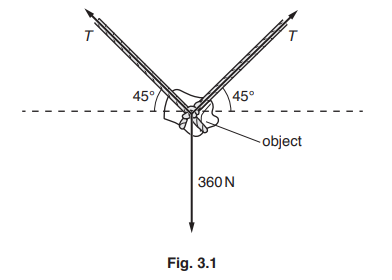Question
(a) An object is moving in a straight line at constant speed.
State three ways in which a force may change the motion of the object.
1 ……………………………………………………………………………………………………………………………..
2 ……………………………………………………………………………………………………………………………..
3 ……………………………………………………………………………………………………………………………..
(b) Fig. 3.1 shows an object suspended from two ropes. The weight of the object is 360 N. The magnitude of the tension in each rope is T.

In the space below, determine the tension T by drawing a vector diagram of the forces acting on the object.
State the scale you have used.
scale …………………………………………………………………………………………..
T = …………………………………………………………………………………………..
Answer/Explanation
Answer:
(a) Accelerate or increase speed OR Decelerate or decrease speed OR Change speed
Change direction OR causes rotation
(b) Sensible scale stated
T vectors, labelled T or with arrow, both of same length, drawn at right angles (any orientation)
Triangle or parallelogram completed using candidate’s T vectors
Correct orientation vector diagram with 360N vector vertical
T value stated: 250 or 260N
Question
(a) Complete the statement by writing in the blank spaces.
The moment of a force about a pivot is equal to …………………………………………………………….
multiplied by …………………………………………………………………………………………….
(b) Fig. 3.1 shows a horizontal rod of length 2.4 m and weight 160 N. The weight of the rod acts at its centre. The rod is suspended by two vertical ropes X and Y. The tension in each rope is 80 N.

(i) State the name given to the point at which the weight of the rod acts.
……………………………………………………………………………………………………………………..
(ii) Calculate the mass of the rod.
mass =………………………………………………
(iii) The rod is in equilibrium.
Using data from Fig. 3.1, explain why.
..………………………………………………………………………………………………………………………..
………………………………………………………………………………………………………………………….
………………………………………………………………………………………………………………………….
………………………………………………………………………………………………………………………….
………………………………………………………………………………………………………………………….
……………………………………………………………………………………………………………………..
Answer/Explanation
Answer:
(a) ..(the) force× its perpendicular distance from pivot / a point
(b)(i) centre of mass
(ii) (mass =) 160 / 10 = 16 kg
(iii) (Not moving up or down because) no resultant (vertical) force
OR upward force = downward force
80 N + 80 N = 160 N
(Not rotating because) no resultant moment (about any point)
OR (sum of) clockwise moments = (sum of) anticlockwise moments
C1clockwise moment (about centre) = 80× 1.2
anticlockwise moment (about centre) = 80 × 1.2
